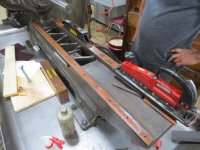cash
Titanium
- Joined
- Aug 8, 2007
- Location
- Greendale,WI
A couple of weeks ago we had to move several of our turret and engine lathes to move in a New Mori Seiki SL403. Once we had repositioned the old lathes, leveled them out we found a major problem with one of our W&S turret lathes. The operator was having a hard time to hold size and after turning the jaws he had a .005" taper in them. Upon further inspection we saw some pretty sever wear on the ways. How we were making good parts before the move, who knows.
The test bar showed a .005" drop within about 6". So now starts the fun to tear this old WWII vintage machine down and get it tuned up.
From some of these initial pictures you can see the situation is pretty dirty. We had this machine realigned about 20 years ago at the former Maintenance Service Corporation in Milwaukee. Now their shop lead man works for me so he gets to rebuild the machine again. The guys at eh shop her think this machine was reworked at least one other time prior to the early 90's.
This machine is used in daily production of one of our product lines. We have another identical machine we use as a back up.
The test bar showed a .005" drop within about 6". So now starts the fun to tear this old WWII vintage machine down and get it tuned up.
From some of these initial pictures you can see the situation is pretty dirty. We had this machine realigned about 20 years ago at the former Maintenance Service Corporation in Milwaukee. Now their shop lead man works for me so he gets to rebuild the machine again. The guys at eh shop her think this machine was reworked at least one other time prior to the early 90's.
This machine is used in daily production of one of our product lines. We have another identical machine we use as a back up.




















